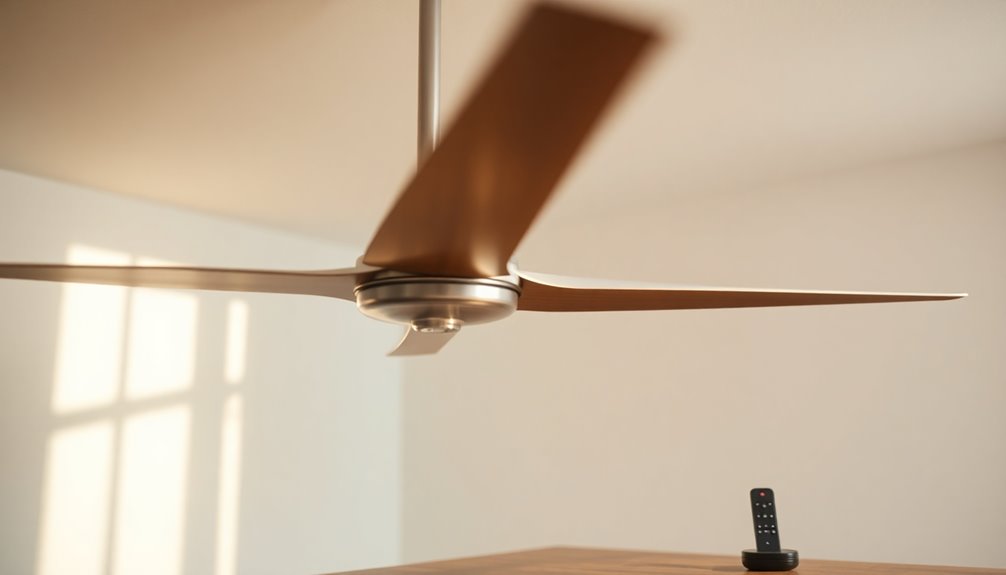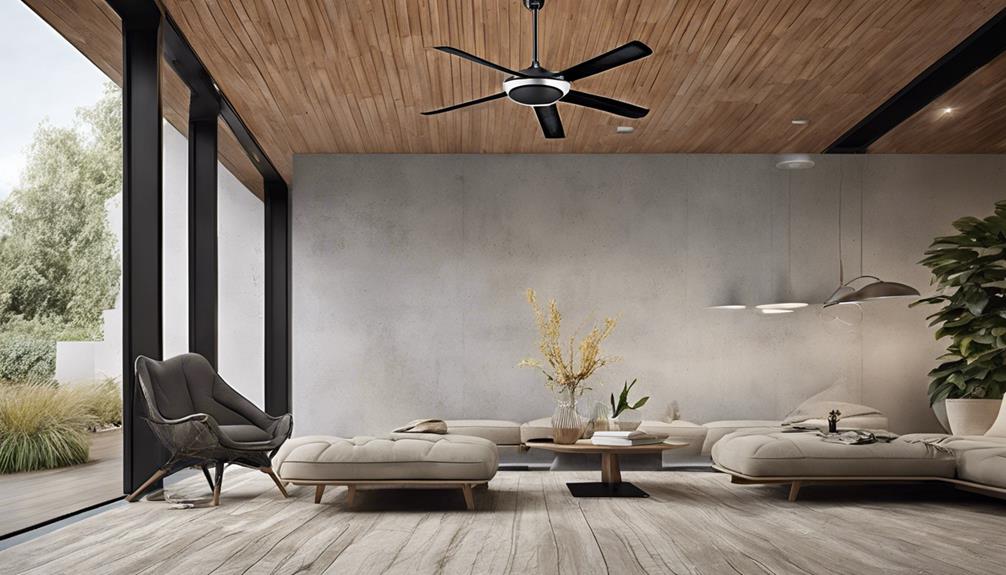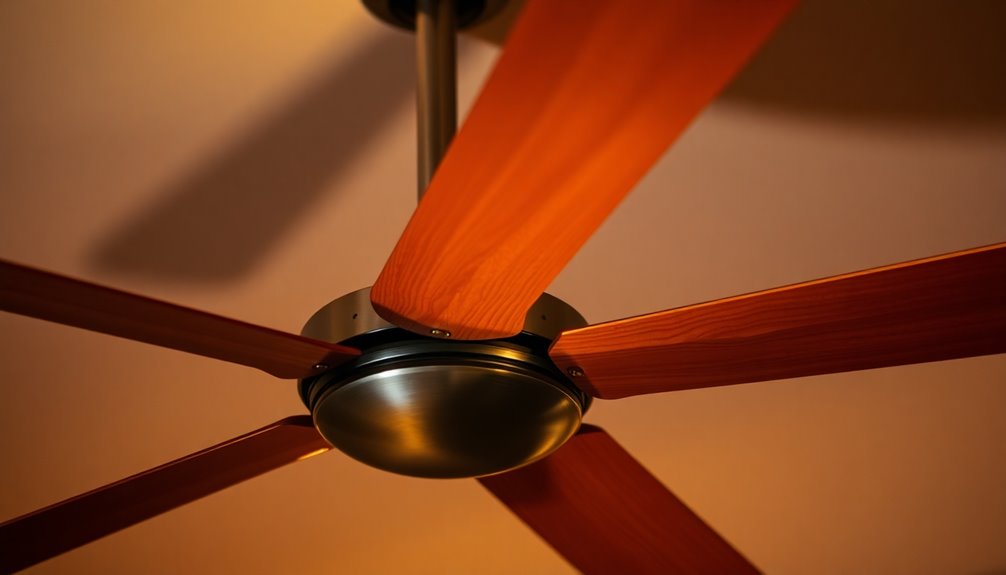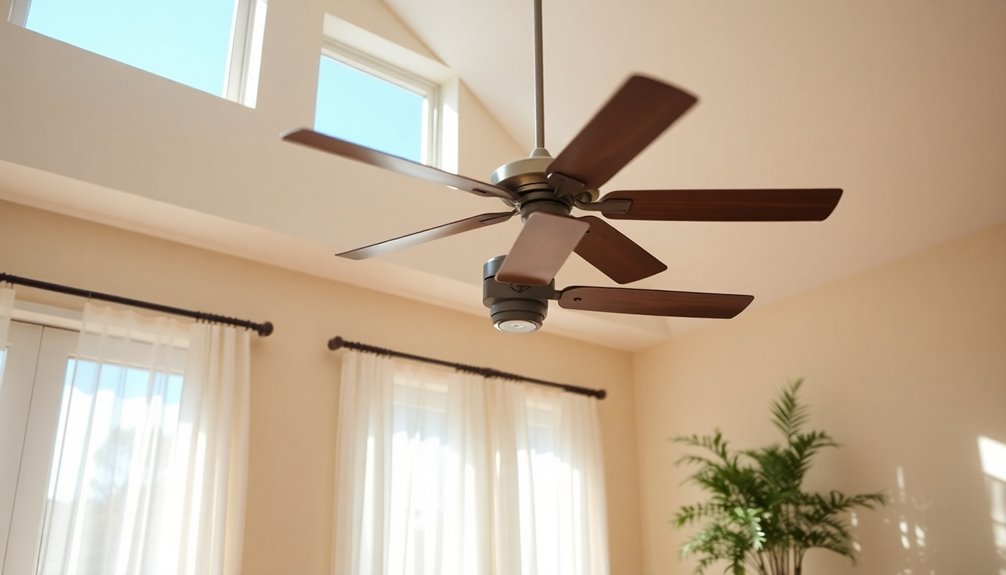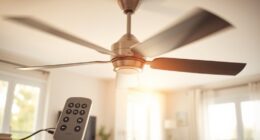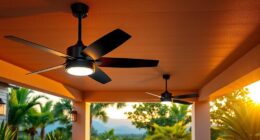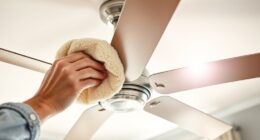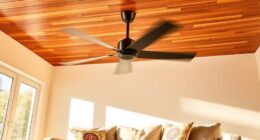Yes, the number of blades on a ceiling fan matters. Fewer blades, like 2-3, can create faster airflow, making them suitable for smaller spaces. More blades, typically 4-5, offer smoother and quieter airflow but may rotate at lower speeds. The ideal blade count also depends on room size—small rooms benefit from 3 blades, while larger areas often require 5 for maximum cooling. Besides blade count, factors like blade pitch, motor power, and design also play a significant role in performance. If you're curious about how to make the best choice for your space, there's more to explore.
Key Takeaways
- Blade count affects airflow dynamics; fewer blades generate faster air movement, while more blades provide smoother, quieter airflow.
- Three-blade fans are ideal for small rooms, delivering powerful airflow, while four or five blades are better for larger areas.
- More blades can reduce rotation speed, impacting overall airflow efficiency; optimal performance often comes from a balance of blade count and motor power.
- The aesthetic design and personal style preferences should also guide choices, as ceiling fans serve both functional and decorative roles in a room.
- Regular maintenance is essential, regardless of blade count, to ensure consistent performance and longevity of the ceiling fan.
Understanding Ceiling Fan Basics
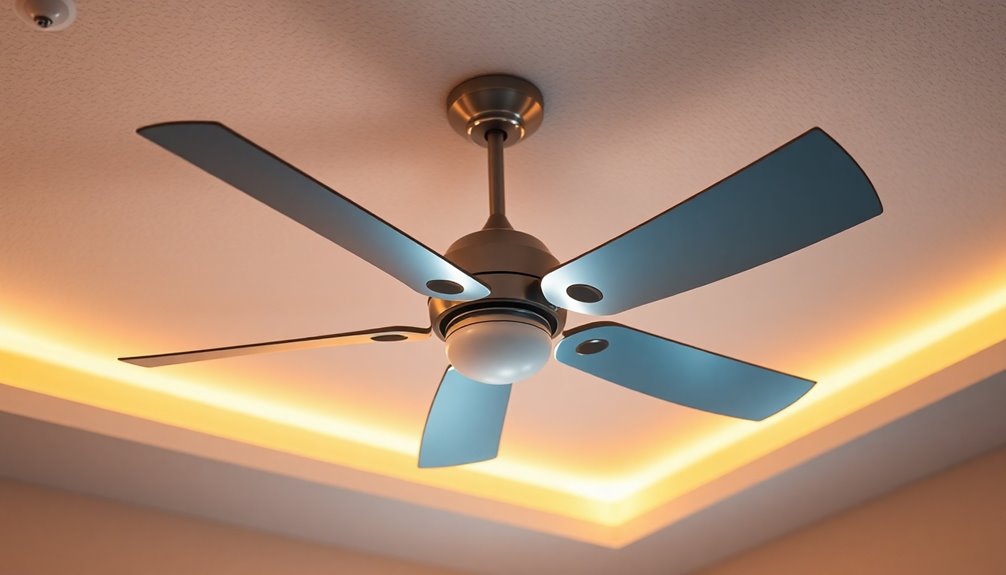
When you think about ceiling fans, it's important to understand how they create airflow in your space. A ceiling fan works by rotating its blades, generating both high and low-pressure zones that influence air movement throughout the room.
The angle of the blades, known as blade pitch, is essential in determining the fan's energy efficiency and effectiveness at moving air. Additionally, the integration of smart home compatibility in modern ceiling fans allows for convenient remote operation.
While it's commonly believed that more blades mean better airflow, that's not always the case. In fact, fans with fewer blades can allow for faster motor speeds, resulting in higher air volume.
The quality of the motor and the design of the blades often play a more significant role in noise levels and operational efficiency than the sheer number of blades.
When choosing a ceiling fan, consider the ideal blade count based on your room size, desired airflow, and your aesthetic preferences. Additionally, selecting a fan with a high CFM rating can greatly enhance your cooling experience.
There isn't a one-size-fits-all answer. By understanding these basic principles, you can select a ceiling fan that meets your needs, enhancing comfort while maintaining energy efficiency.
The Impact of Blade Count
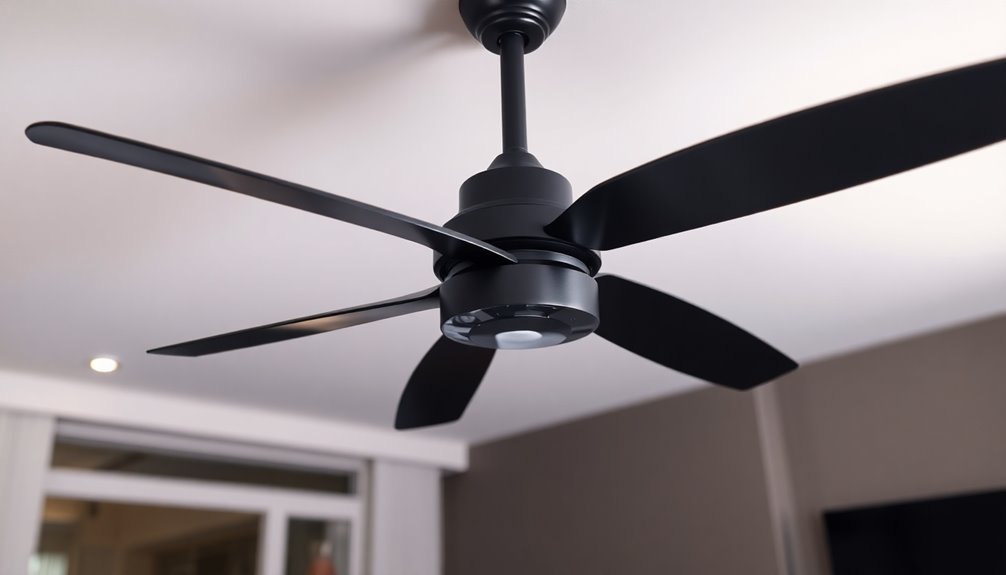
The impact of blade count on ceiling fan performance can't be overlooked, as it plays an important role in airflow dynamics. When you choose a ceiling fan, you might think that the number of blades directly correlates with better airflow. However, ceiling fan experts suggest that factors like blade pitch and motor power are more significant.
For instance, fans with fewer blades, such as two or three, can promote faster motor speeds, resulting in higher air volume and effective air circulation. In contrast, four or five blades create a smoother and quieter airflow, though they may slow down rotation due to increased drag.
Standard residential fans typically feature three to five blades, with five-blade models often designed for ideal air distribution in larger rooms. While aesthetics can influence your decision, keep in mind that performance differences may not be as significant as you think.
If you're looking for enhanced efficiency, consider that industrial applications often use fewer blades to maximize airflow. Ultimately, when selecting your ceiling fan, balance the number of blades with considerations like blade pitch and motor power for the best results in airflow and comfort.
Room Size and Fan Selection

Choosing the right ceiling fan goes beyond just considering blade count; room size and ceiling height play significant roles in your selection process.
Understanding these factors guarantees you achieve ideal air circulation, enhancing your comfort and the space's aesthetic.
Here's how to select the right fan based on room size:
- Small to Medium Rooms (up to 150 sq. ft.): Opt for a 3-blade fan. It provides powerful airflow without overwhelming the space.
- Medium to Large Rooms (150 sq. ft. – 400 sq. ft.): Either a 3-blade or 5-blade fan works well here, balancing airflow and motor power for effective performance.
- Extra Large Rooms (over 400 sq. ft.): A 5-blade fan with a powerful motor is essential for effective air circulation throughout the entire area.
Additionally, consider ceiling height in your fan selection.
Standard ceilings (8 – 9 ft.) work well with both 3 and 5-blade fans, while high ceilings (over 9 ft.) may need downrod extension kits, favoring 5-blade fans for improved airflow.
This tailored approach guarantees you maximize comfort and efficiency in your chosen environment.
Aesthetic vs. Functional Choices

A variety of factors come into play when weighing aesthetic versus functional choices for ceiling fans. One major element is blade count. If you lean towards a modern, sleek look, a 3-blade fan might be your best bet.
However, for a more traditional touch, 4 or 5 blades can provide that substantial aesthetic appeal. Fans with 6 or more blades often showcase industrial designs and create bold statements, aligning with specific decor styles.
While you might prioritize aesthetics, remember that blade count doesn't greatly impact air circulation. Instead, aspects like blade pitch and motor power play a vital role in performance. You may find yourself drawn to fans with more blades for their classic appearance, but these choices can also contribute to quieter operation and smoother airflow.
Today's ceiling fan design has evolved to harmonize aesthetics and functionality. Modern technology guarantees effective airflow regardless of blade count. Additionally, just like with projectors, color accuracy can enhance the overall visual experience in a space when considering complementary design elements.
Performance Factors Beyond Blades
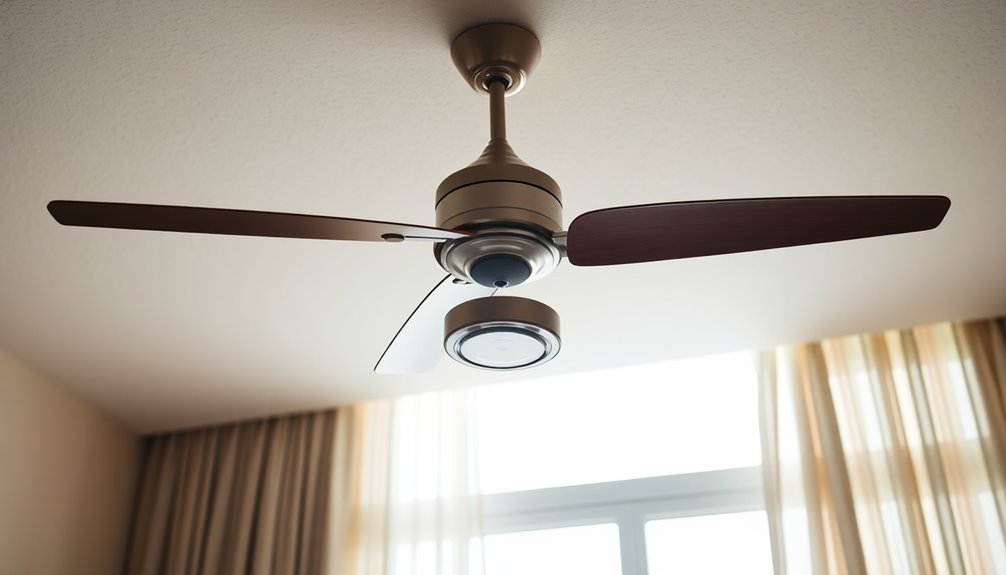
While blade count can influence the look of a ceiling fan, other performance factors deserve your attention. To guarantee peak cooling power and comfort, consider these key elements:
- Motor Power: A more powerful motor rotates the ceiling fan blades faster, leading to more powerful airflow. This can greatly boost the effectiveness of your fan.
- Blade Pitch: The angle of the blades, known as blade pitch, plays a vital role in airflow dynamics. An ideal pitch of 13-15 degrees maximizes airflow efficiency, enhancing the wind chill effect for better comfort.
- Blade Design: The shape and materials of the ceiling fan blades impact their performance. Well-designed blades can improve airflow consistency, assuring you feel a cool breeze regardless of the number of blades.
Evaluating Popular Blade Configurations

When choosing a ceiling fan, you'll want to contemplate how different blade configurations can impact performance and style.
Two-blade fans offer a sleek look with high airflow, while three-blade options are perfect for smaller spaces.
If you're looking for balance in larger rooms, four to five blades provide effective air circulation and modern design.
Two-Blade Fan Benefits
Two-blade fans offer a unique blend of style and efficiency that can enhance your living space.
These fans, like the Craftmade Illusion, are designed not only for modern aesthetics but also for peak functionality. With their powerful motor, they achieve high airflow while maintaining a stylish appearance.
Here are three key benefits of two-blade fans:
- Energy-efficient: Their design allows for less power consumption while effectively moving air, making them a smart choice for eco-conscious individuals.
- Quieter operation: The aerodynamic design results in smoother airflow, ensuring a peaceful environment, perfect for open spaces or bedrooms.
- Sleek design: The contemporary look of a two-blade ceiling fan adds elegance to small to medium-sized rooms, combining form with function.
Three-Blade Fan Efficiency
Three-blade fans have gained popularity for their sleek design and impressive efficiency, making them a top choice for many homeowners.
These fans are particularly suited for small to medium-sized rooms, up to 150 sq. ft., where they deliver ideal air movement without being overwhelming. With three blades, they often achieve high motor speeds, resulting in efficient airflow that circulates air effectively while keeping noise levels in check.
One standout example is the Maverick Max, which boasts a 70-inch blade span and is damp-rated for both indoor and covered outdoor use, showcasing its versatility.
The aerodynamic design of three-blade fans enhances the wind chill effect, providing a revitalizing cooling sensation without the need to lower the room's temperature considerably. This means you can enjoy comfort while potentially saving on energy costs.
Four to Five Blades
Ceiling fans with four or five blades are popular choices for homeowners looking to strike a balance between style and functionality. Both configurations offer unique benefits, making them suitable for various room sizes and aesthetics.
- Airflow Efficiency: Five blades generally provide better air circulation, making them ideal for medium to large rooms. Their design promotes ideal airflow, enhancing overall effectiveness.
- Blade Pitch: Most four and five-blade fans are engineered with a blade pitch between 13-15 degrees. This angle maximizes airflow while maintaining quiet operation, as the fans work more efficiently with less noise.
- Design Appeal: While four blades present a sleek, contemporary look, five blades often deliver a more traditional aesthetic with steady airflow. The choice between the two can depend on your room's decor and your personal style.
Ultimately, whether you choose four blades or five blades, both configurations can effectively cool your space.
Just keep in mind the size of your room and your design preferences to guarantee you select the ceiling fan that best meets your needs.
Making an Informed Decision
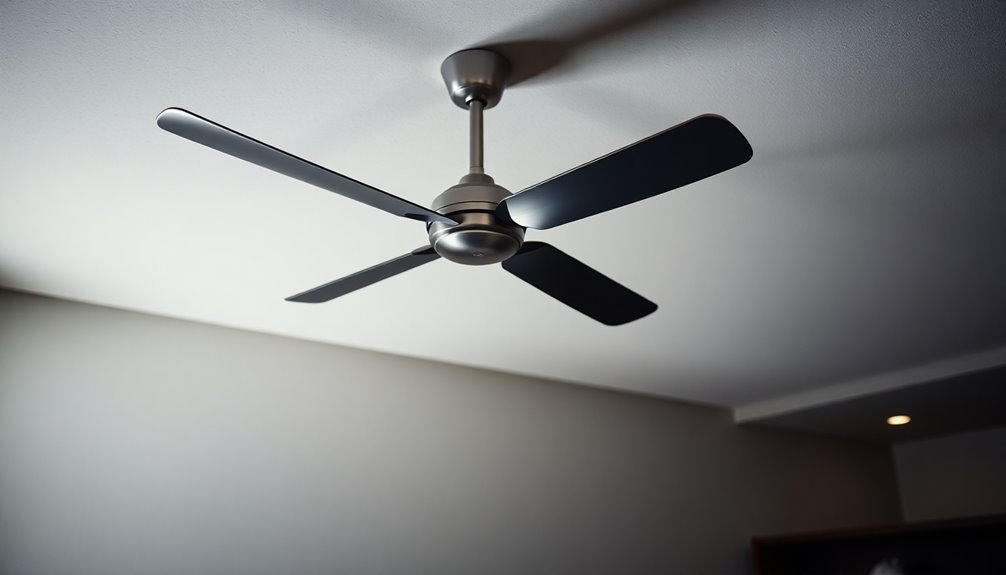
When choosing a ceiling fan, considering the number of blades is just one piece of the puzzle. To make an informed decision, you need to think about how the number of blades affects airflow dynamics and energy consumption.
Generally, a 3-blade ceiling fan provides faster air movement, ideal for smaller rooms. In contrast, 4 or 5 blades can create a smoother, quieter airflow, especially important in medium to large rooms.
However, don't overlook other vital factors like blade pitch and motor power. These elements greatly impact airflow efficiency, sometimes more than blade count alone. For instance, a fan with a higher blade pitch can move air more effectively, regardless of the number of blades. Additionally, regular maintenance can help ensure optimal performance and longevity of your ceiling fan.
Additionally, aesthetics matter. A fan can serve as a stylish statement piece in your décor, so choose a design that complements your space.
Ultimately, weigh your specific needs against the characteristics of the ceiling fan. By considering the number of blades alongside these other factors, you'll be better equipped to select a ceiling fan that enhances both comfort and style in your home.
Frequently Asked Questions
Is a Fan With 5 Blades Better Than 3?
When you're deciding between a 5-blade and a 3-blade fan, consider what you need.
A 5-blade fan often offers smoother and quieter airflow, which might suit your preference for peace.
However, if you need more air circulation and don't mind a bit of noise, a 3-blade fan could be the way to go.
Ultimately, it's about your space and comfort; both can perform well depending on specific conditions.
Which Is Better a 3 or 4 Blade Ceiling Fan?
Imagine a warm summer night, and you're dreaming of a cool breeze.
When choosing between a 3-blade or 4-blade ceiling fan, it really boils down to your needs. A 3-blade fan suits smaller spaces and offers brisk airflow, while a 4-blade fan provides a quieter, smoother experience in larger rooms.
Consider your room size and the ambiance you want to create to find the perfect balance between performance and comfort.
Is It Better to Have More or Less Blades on a Ceiling Fan?
When deciding whether to go for more or fewer blades on your ceiling fan, consider how you want the airflow to feel.
More blades can create a smoother, quieter breeze but mightn't move air as efficiently.
Fewer blades can spin faster, producing stronger airflow but can feel choppier.
Ultimately, it's about your personal preference for aesthetics, noise level, and the specific needs of your space.
Choose what suits you best!
What Is the Best Number of Blades for a Ceiling Fan?
Ever wondered what the best number of blades is for your ceiling fan?
It really depends on your specific needs. If you're looking for powerful airflow in a smaller room, 3 blades might be ideal.
However, for larger spaces, 4 or 5 blades can balance airflow and aesthetics.
Keep in mind that blade pitch and motor power are just as important, so consider those factors when choosing your perfect fan!
Conclusion
In the grand dance of ceiling fans, the number of blades isn't the sole star of the show. While it can influence airflow, your choice should also embrace the room's spirit and your personal style. So, whether you fancy a sleek four-blade model or a classic five-blade design, remember that performance and aesthetics go hand in hand. Choose wisely, and let your fan whisk you into a revitalizing breeze that perfectly complements your space.

